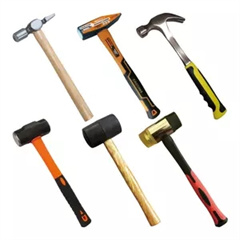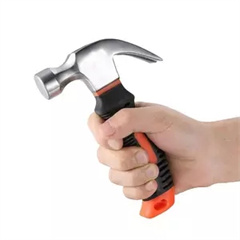The journey of a hammer from the hands of a blacksmith to becoming a crafted tool in the possession of a skilled artisan is a fascinating one that encompasses the art of blacksmithing, the principles of craftsmanship, and the appreciation for handcrafted tools. Let’s explore this journey step by step:
- Material Selection and Forging:
- The journey begins with a blacksmith selecting the right type of steel, considering factors like hardness and durability.
- The blacksmith heats the steel in a forge until it’s malleable, ready to be shaped.
- Using an anvil and various hammering techniques, the blacksmith forms the hammerhead, striking face, and peen.
- Heat Treatment and Tempering:
- To ensure the hammerhead’s strength, it undergoes heat treatment. It’s heated to a specific temperature and then rapidly cooled through quenching.
- The hardened hammerhead is then tempered by reheating to reduce brittleness while maintaining strength.
- Handle Preparation and Fitting:
- A handle, often made from hickory wood, is carefully selected and shaped to fit the hammerhead’s eye.
- The handle is inserted into the eye, and a wooden wedge is driven into a slot at the end of the handle to secure it within the hammerhead.
- Finishing and Personalization:
- The hammer is sanded, polished, and any rough edges are smoothed out, enhancing its appearance and feel.
- Some blacksmiths add decorative touches or engravings to give the hammer a unique and personalized character.
- Quality Control:
- The crafted hammer undergoes thorough quality checks to ensure its weight, balance, and structural integrity meet the desired standards.
- Transition to the Craftsman:
- Once the blacksmith’s work is complete, the handcrafted hammer is ready to embark on a new journey as a tool for a skilled craftsman.
- Craftsman’s Perspective:
- The craftsman, whether a carpenter, metalworker, or artisan from another discipline, recognizes the value of a well-made tool.
- They appreciate the balance, weight distribution, and ergonomics that the blacksmith’s craftsmanship brings to the hammer.
- Tool in Action:
- The crafted hammer becomes an extension of the craftsman’s skills and creativity.
- It assists in shaping wood, metal, or other materials with precision and control, enabling the realization of intricate designs or functional objects.
- Relationship with the Tool:
- The craftsman develops a relationship with the hammer, relying on it for consistent performance and becoming attuned to its nuances.
- Continuation of Tradition:
- The journey of the handcrafted hammer carries forward the legacy of blacksmithing and craftsmanship.
- The hammer becomes a symbol of dedication to the art of making, connecting the craftsman to centuries-old traditions.
From the labor-intensive forging process in the blacksmith’s workshop to the skilled hands of a craftsman shaping the materials they work with, the journey of a handcrafted hammer is a testament to the merging of art, technique, and utility. It highlights the enduring appeal of artisanal craftsmanship in a world dominated by mass production.



































